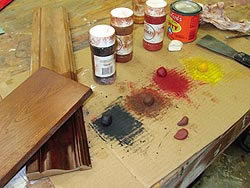| PaintPRO Archives — Decorative Painting Tips |
Custom-colored putty for wood finishing
You can readily make subtle changes in color by making putty into pure colors and intermix the colored putty to make your custom color.
by Ron Saylor, Saylor Painting Co., Eugene, Ore.

tint putty to match wood colors using Universal Tinting Colors (UTC’s). The method works but it has a couple of flaws. Adding a shot of color here and a shot of color there can easily result in a wasted hour and a glob of purple putty the size of a baseball. Adding enough UTC to get a deep color doesn’t produce colored putty. It produces thickened colorant — too soupy to be useful.
To the first problem: Don’t mix several colors into one ball of putty. When adding one color after another into the same piece of putty it is difficult to gauge the impact of each addition. Make putty into pure colors and intermix the colored putty to make your custom color. You can readily make subtle changes in color.
It is easy to vary your formula to match changes in the wood color. You don’t have to make a large batch to do the whole job. You can make a small batch, constantly tuning it as you use it, and quickly make a fresh clean batch when it starts getting muddy.
Now for the soupy putty problem: Don’t use liquid color. Buy dry pigments at an art supply store. If you are experienced with the liquid UTC colors you probably know to use whiting or corn starch to stiffen your mix. Using dry pigment eliminates this problem and allows you to get very deep, bright colors, impossible with UTC’s. You may actually need a few drops of linseed oil to balance the dry ingredients added. The drier your putty mix, the less shrinkage. Your fills don’t dimple very much as they dry.
It is best to check your color accuracy with a coat of finish over it.

|

